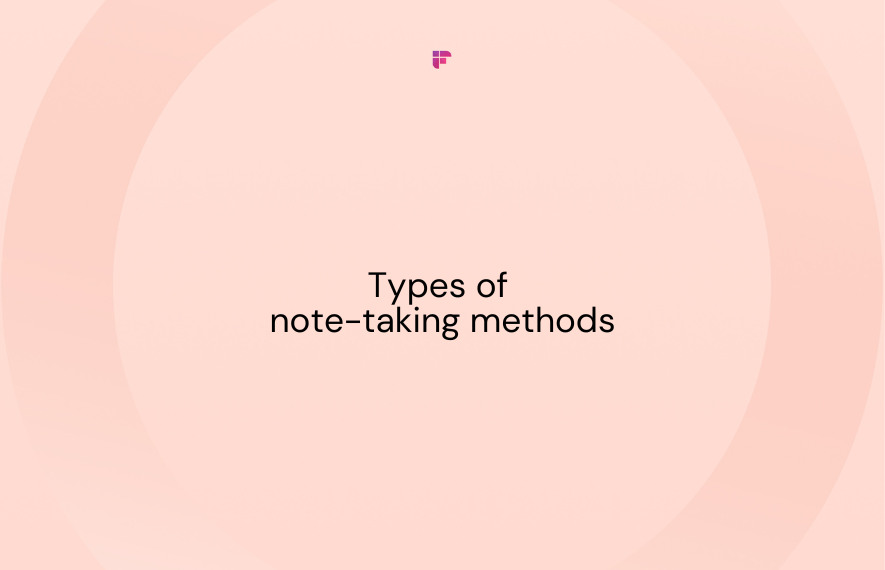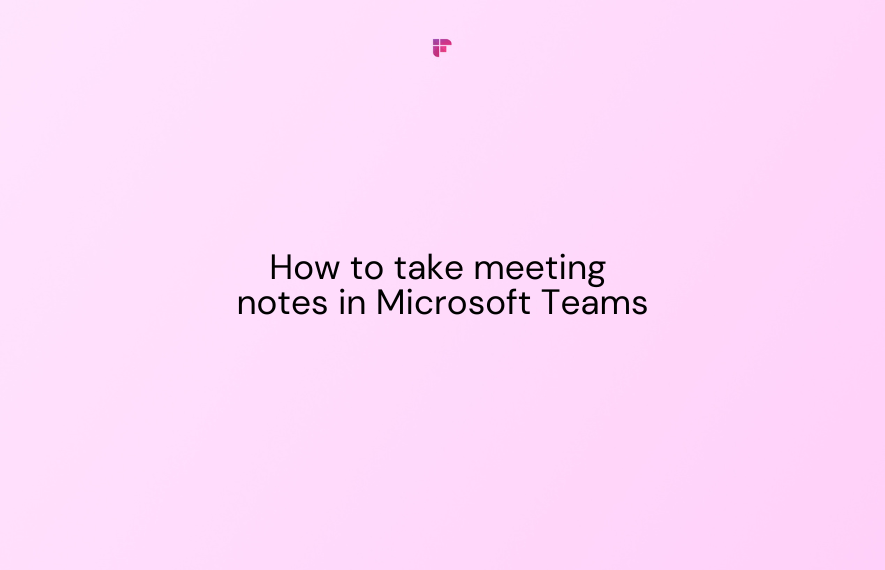Note-taking is not about frantically transcribing every word or mindlessly copying information without comprehension. Instead, it is a strategic process that involves active engagement and thoughtful organization.
This blog will take you through the top seven types of note-taking methods that you can follow to stay organized, focused, and remember important information.
Read on!
7 types of note-taking methods
Studies by the University of North Carolina suggest note-taking is an important skill needed for professional success. It helps you focus better and understand things more deeply.
Here are the 7 different types of note-taking methods you can follow in various situations:
- The sentence method for fast-paced live sessions
- The outline method for complex topics
- The Cornell method for organization and recall
- The flow-based note-taking method for creative thinking
- The mapping method for summarizing information
- The charting method for understanding correlations
- The T Notes note-taking method for organizing data
1. The sentence method for fast-paced live sessions
If you're in a situation where meetings or lectures are moving quickly, and you don't have much time to jot down notes, the sentence method can help you record the information correctly.
Just write complete sentences, separated by lines, for important points.
It's great for capturing key info on the spot, but it might be challenging to make sense of it later. It's best to use this method only for quick notes and turn them into a proper format right after the session.
This way, you won't be overwhelmed trying to remember the context of the topics you covered.
Try Fireflies for free today!
Pros
- It's quick and efficient
- Suitable for any subject or type of class
- Allows for making connections between concepts
Cons
- Challenging to review your notes later
- Challenging to condense and summarize information effectively
- Less interactive learning experience due to overemphasis on note-taking

2. The outline method for complex topics
The outline method is used to organize information in a hierarchical structure using bullet points or indentation to show relationships between main ideas, subtopics, and supporting details.
It captures the structure and hierarchy of the content, making it easier to see the overall framework and connections between different concepts.
Use it during lectures or meetings to understand the entire concept at a glance, as it helps the user to recall the sequence.
Try Fireflies for free today!
Begin by outlining the main idea or topic at the top of the page. Then break it down into subtopics or sections and add as many details as needed. This is great for outlining complex topics and logically organizing your thoughts.
Pros
- Preferred method for sequential topics
- Great for visual learners
- Easy and quick to grasp before exams
- Highly flexible, allowing note-takers to add, rearrange, or expand information
Cons
- It may take longer to write notes when using this method
- Loss of detail due to condensation of information
- Meetings need a clear structure

3. The Cornell method for organization and recall
The Cornell method was developed half a century ago by Walter Pauk, a professor from Cornell University. It's a systematic approach that helps organize and review information effectively.
To use this method, split your note-taking paper into three pieces. There should be a small column on the left, a broader column on the right, and a space at the bottom.
The thin column on the left notes essential points, questions, or prompts to aid with material memory and revision. The larger column on the right is for taking more thorough notes and expanding on important ideas. Finally, the summary area at the bottom is for summarizing and reviewing remarks.
This method allows you to quickly jot down key points on the left side of the page and leave room for summaries and questions or comments on the right.
Pros
- Easy to review and recall in question-and-answer format.
- Encourages active listening and engagement.
- Time-saving since it needs little effort.
- Suitable for extracting major ideas and concepts.
- Organized and systematic when taking and examining notes.
Cons
- Requires more space compared to traditional note-taking styles.
- It can be difficult to arrange a high volume of notes.
- The initial setup of dividing the pages into sections can take time or may require the use of Cornell notebooks/sheets.

4. The flow-based note-taking method for creative thinking
The flow-based note-taking method is a dynamic approach that focuses on capturing information in a continuous, interconnected flow.
Rather than relying on rigid structures or predefined sections, this method encourages note-takers to visually represent ideas and concepts as they naturally unfold.
The process begins by jotting down the main idea or concept on a sheet of paper. Then, draw arrows and lines connecting related concepts to form clusters.
If a concept relates to more than one cluster, create a line going in both directions between them. Utilize different sizes, colors, or visual elements to establish a hierarchy of importance within your notes. Emphasize critical points or key ideas through visual cues like bolding, underlining, or highlighting.
Pros
- Great for creative thinking and problem-solving
- Encourages learning by actively engaging with the content
- Suits most subjects or types of classes
- Easy to personalize notes to fit your needs
Cons
- It may take longer to write down notes using this method
- Needs more practice before using it
- Not suited for individuals who prefer a structured approach
- It might be challenging to use during fast-paced meetings or lectures
- Limited text-based details and may need supplementary notes or annotations

5. The mapping method for summarizing information
The mapping method of note-taking involves creating a visual map or diagram that represents the relationships between different ideas, concepts, and information.
This method focuses on capturing the main topic or central idea in the center of the page and branching out with connecting lines to subtopics, supporting details, and related concepts.
You can start by summarizing the main topic and brainstorming ideas to form a visual map. Connect these concepts to create an organized overview of a subject or idea. This makes it easier to review and remember the important points later on.
Pros
- Helps organize ideas without getting overwhelmed with lots of text
- Lets you understand and identify important concepts within a topic
- Helps you easily remember concepts by visualizing
- Encourages active listening and engagement
Cons
- Needs more space depending on the complexity of the subject
- Requires you to have a good understanding of the subject
- Limited text-based details
- Time-consuming to create concept maps
- Not suited for fast-paced sessions

6. The charting method for understanding correlations
The Charting method is a note-taking technique that involves organizing information in a structured and visually appealing manner using columns and rows.
It is particularly useful for capturing and summarizing information from lectures, textbooks, or presentations. The Charting method helps improve your lectures' organization, comprehension, and retention.
To begin, create a table on your paper with columns and rows tailored to the type of information you aim to capture. Identify the main categories or topics you want to cover as column headings, enabling a clear organization of your notes.
As you read, listen, or attend a meeting, diligently fill the rows with key information, aligning each row with a specific point, idea, or subtopic related to the main headings.
The Charting method can be used to organize information from lectures, books, articles, interviews, conference calls, etc.
Pros
- Allows for a more visual representation of information
- Helps with memory recall and comprehension of complex material
- Can be used for problem-solving and data analysis
- Helps to develop higher-order thinking skills
Cons
- Might not be applicable to geography, philosophy, and language classes
- Due to the focus on summarization, this method may not capture all the nuanced details

7. The T Notes note-taking method for organizing data
The T Notes note-taking method is a structured approach that involves dividing your paper into two columns, forming a "T" shape. This method helps organize and summarize information during lectures, discussions, or readings.
It's ideal for students, teachers, professionals, and anyone who needs to take notes quickly and efficiently.
The process is simple — you begin by writing your main topics at the top of a page, then add subtopics underneath each one. Below each subtopic, you can include a brief explanation or notes about the topic.
This way, all of your information is presented in an organized manner, and it's easy to follow.
Pros
- Helps organize large amounts of information
- Easy to review and recall notes
- Easy to add or expand new information
- Can be adapted to different learning styles and subjects
Cons
- Challenging to recall all the details if the notes aren't organized properly
- It can take longer to set up the grid system
- It may not accommodate non-linear or more creative thought processes
- Not suited for topics that need extensive information and details
- Less suitable for verbatim transcription

Final note,
There it is, the seven types of note-taking methods, each offering its own unique benefits and applications.
Remember, note-taking is not a one-size-fits-all endeavor. It is essential to experiment with different methods, adapt them to suit your preferences, and refine your approach over time.
Go forth, experiment these methods one at a time and unlock your full potential as a learner, thinker, and creator.





